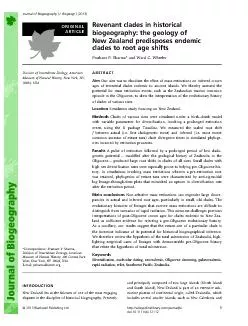/


higherprobabilityofgoingextinctastimeincreasesIntheabsenceofextrinsicperturbationstothenetdiversi ID: 609265
Download Pdf The PPT/PDF document "ChathamIsland(Neall&Trewick,2008).Zealan..." is the property of its rightful owner. Permission is granted to download and print the materials on this web site for personal, non-commercial use only, and to display it on your personal computer provided you do not modify the materials and that you retain all copyright notices contained in the materials. By downloading content from our website, you accept the terms of this agreement.
ChathamIsland(Neall&Trewick,2008).ZealandiaseparatedfromthesupercontinentGondwana90Maanditscon-stituentislandshavebeenisolatedfromnearbycontinentalmargins(e.g.Australia)foraperiodinexcessof55Myr(reviewedbyNeall&Trewick,2008;butseeSchellartetal.2006onthesubsequentcompletionofgeologicalseparation).Accordingly,thebiotaofNewZealandcanbedividedintotwocategories:palaeoendemiclineagesofputativelyGondwanancharacter(Nelson,1975;Cooperetal.,2001;Ericsonetal.2002;Stetal.,2002)andneoendemicsthatcolonizedislandsbylong-distancedispersal(McGlone,2005;Waters&Craw,2006;McDowall,2008).OwingtoitsinclusionamongtheremnantsofGondwana,NewZealandhashistoricallyÞg-uredprominentlyinstudiesofcircum-Antarcticbiogeography(e.g.Nelson&Platnick,1981;Sanmartõn&Ronquist,2004).ThenatureofthedisputeoverthebiotaofNewZealandstemsfromthegeologyofZealandiaintheOligocene,aper-iodofsubstantialmarineincursion(Cooper&Cooper,1995;etal.,2008)duringwhichNewZealandÕssurfacewasgreatlyreducedinsize(Cooper&Millener,1993).Morerecently,thehypothesisofthecompletesubmersionofNewZealandduringtheOligocenehastakenhold(McGlone,2005;Waters&Craw,2006;Trewicketal.,2007;Landisetal.,2008;Crispetal.,2011).TheimplicationofthishypothesisisthatNewZealandisadefactooceanicisland,despitebeingcomposedofcontinentalcrust(Trewicketal.2007);thebiotaofNewZealandthusconsistsexclusivelyofneoendemicsthatcolonizedtheislandandradiatedinthelast22Myr(Landisetal.,2008).TheÔOligocenedrowningÕhypothesisdrawsupon(1)geologicalevidenceofplate-thinningandsubsidence,withaconcomitantabsenceoflateOligoceneterrestrialdeposits(Landisetal.,2008),and(2)theabundanceofmolecularphylogeneticstudiesthatindi-catepost-Oligocenedivergencedatesofmanyendemiclineagesoncethoughttorepresentpalaeoendemics.Thegeologicalevidencethatisfrequentlycitedinfavouroftotalmarineinundationisinfactfarfromconclusive.Waters&Craw(2006)arguedthatthereisÔnodirectevi-denceforcontinuouslyemergentlandthroughthemiddleTertiaryÕ,butconcededthatÔresolutionofrockagesistoolowtoallowconclusivedeÞnitionoftimesofcompletesub-mergence,oranemergentarchipelagoÕ(Waters&Craw,2006,p.352);thatis,thegeologydoesnotfavoureitherhypothesis.Similarly,Trewicketal.(2007)stronglyfavouredthehypothesisofcompletesubmergence,whichimpliesthattheentirebiotacannotpre-date2225Ma.Buttheynever-thelesshedgedthisbet:ÔOfcourseanemergentNewZealandarchipelagodoesnotprecludeZealandiahavinghadaGond-wanan(vicariant)biotapriortosubmergenceintheOligo-cene,orthepossibilitythatsomelineagessurvivedÕ(Trewicketal.,2007,p.4).Finally,Landisetal.(2008)reviewedgeo-logicalevidenceformarineincursionandcorroboratedmajoraspectsobservedbyWaters&Craw(2006):thereisÔnogeologicalevidencetoindicatethatlandareaswerecon-tinuouslypresentÕandÔtheNewZealandsubcontinentwaslargely,orentirely,submergedÕ(Landisetal.,2008,p.173).Toourknowledge,nogeologicalworkhasunequivocallyclaimedcompleteandunambiguousinundationofNewZea-Thepurposeoftheaforementionedseriesofstudies,whichfavouraninundationscenario(completeorotherwise),hasbeentoquestionpreviousassumptionsoftheGondwananoriginofNewZealandendemiclineages.ThiscritiquehasprovedtobelargelyvalidformanyNewZealandcladesandspecies,whichinfactappeartorepresentpost-Cretaceousradiationsofcolonists.Forexample,manyoftheendemicNewZealandlineagesoncethoughttohavebeenofGond-wananoriginweresubsequentlydemonstratedtobetooyoungtobeattributedtovicariance.Theseincludethesouthernbeech(;Swensonetal.,2001;Cook&Crisp,2005),thegalaxiidÞshes(Burridgeetal.,2012),thekauri(;Knappetal.,2007;BifÞnetal.,2010)andthemoas(Phillipsetal.,2010),amongothers.Inothercases,outrighttransoceanicdispersalstoNewZealandinthepost-Oligoceneaccountforseveralneoendemicradiations,espe-ciallyamongplanttaxa(e.g.Spaliketal.,2010).Furthermore,ancientlineageswithfewspecies,termedrelicts,aredisfavouredforbiogeographicalinferencebecausetheycannotfalsifythecontinuouspersistenceofalandmassthroughtimeintheabsenceofadetailedfossilrecordetal.,2011).Forexample,thetwoextantspeciesof(thetuataras)areendemictoNewZealandandaretheonlysurvivingrepresentativesofthesisterlineagetothesquamates,buttheydonotinformNewZealandÕsbioge-ography,insofarasthedivergenceofthetwospeciesisveryrecentandtheirfossilrecordinNewZealanddoesnotpre-datetheOligocene.Asaconsequence,itisnotfeasibletofalsifyalternativebiogeographicalscenarios,suchasthedis-persalofthetuataratoNewZealandaftertheOligocenewithsubsequentextinctionseverywhereelse.AnotherrelictualtaxonendemictoNewZealandisthefroggenus(fourextantspecies),whichdivergedfromitssisterlineageintheLateTriassic(Roelantsetal.,2007).Thestandardacceptedforrefutationofpre-Oligoceneevo-lutionaryhistoryhastypicallybeentotestwhetherthecrownroot,ordiversiÞcation,age(typicallywithaconÞdenceinter-val)ofanendemicNewZealandlineagecoincideswithorpre-datestheOligocenedrowning.IfaspeciÞcdivergenceistooyoung,bothpre-Oligocenehistoryand,asacorollary,avicariantoriginforacladecanberejected(Crispetal.2011).Theassumptioninherenttothisframeworkisthattheinferredrootageisequaltotheactualrootageoftheendemicclade.Thisassumptioninturnhingesuponthesuppositionthatextinctiondoesnotaffecttheestimationoftherootage.ThisisbecauseSlowinski&Guyer(1989)showedthattheprobabilityofalineagesurvivingtotimegivenbyaretheprobabilitiesofcladogenesisandextinction.AcorollaryofthisequationisthatwhenthenetdiversiÞcationrate()islow,agivenlineagehasaJournalofBiogeography2013BlackwellPublishingLtdP.P.SharmaandW.C.Wheeler higherprobabilityofgoingextinctastimeincreases.IntheabsenceofextrinsicperturbationstothenetdiversiÞcationrate(e.g.massextinctions),theobservablerootage(i.e.themostrecentcommonancestor,MRCA,ofextanttaxa)isinvariablyequaltotheactualrootageifandonlyifequaltozero.Anon-zerovalueofinabirthdeathmodelisexpectedtoengenderagapbetweenobservedandactualnodeages,especiallyforoldclades(seeAppendixS1:Fig.S1inSupportingInformation).Neitheroftheseconditionstheabsenceofextrinsicperturbationsornon-zeroappliesinthecaseofNewZealand.AnalysisofdiversiÞcationratesinNewCaledonia,aZealandianislandthatemerged34Ma(Grandcolasetal.2008),hassuggestedthatdensity-dependentmodelsofclado-genesis(i.e.decreasingnetdiversiÞcationratesovertime)aresuitablefordescribingthepatternofmanyendemicradia-tions(Espeland&Murienne,2011;butforalternativeinter-pretationsofdiversiÞcationratedeceleration,seeRabosky&Lovette,2008;Rabosky,2009;Cusimano&Renner,2011;etal.,2012).InspiteofNewZealandÕscomparativelygreatersize,aperiodofdecreasingnetdiversiÞcationrateisexpectedinthe3580Maperiod,duringwhichNewZea-landcouldplausiblyhavereachedcarryingcapacityformanyoldlineages,andinthe24Mapresentperiod,whenNewZealandÕsgeologyandbiotatooktheformsobservedtoday.Furthermore,amarineincursionofanysizeisanticipatedtocauseextrinsicextinction(unrelatedto).IfNewZealandwerereducedtoanemergentarchipelagoforthedurationoftheOligocene,theeffectontheendemicterrestrialbiotacouldbestbedescribedasaprolongedmassextinctionWethereforeinvestigatedtheeffectsofasimulatedperiodofextinction,comparableinproÞletothegeologicalhistoryofNewZealand(Fig.1a),ontherootagesofsimulatedende-micterrestrialclades.Acardinalelementofthismodellingisthatavicariantoriginofthesimulatedcladeisnotinvoked;thesimulationconditionscouldequallywellapplytoataxonthatdispersedtoageologicallydynamiclandmasspriortothemassextinctionevent.ThusonlyaÔpre-OligoceneÕhistoryisstipulated.WewerespeciÞcallyinterestedinhowextinctionaffectstheinferablerootageofcladesofvarioussizes,becausethediversityofcladesonislandsisextrinsicallyconstrainedbylandmassavailability.Recenttheoreticalworkhasdemonstratedthatmassextinctionscancauseshiftsintherootageofvirtualcladesetal.,2012),althoughunderthosesimulatedcondi-tionsthemajorityofcladesretainedaninferablerootageapproximatelyequaltotheiractualrootageevenunderstrongepisodesofextinction.Here,weshowthattheOligo-cenebottleneckispredisposedtocausingsigniÞcantrootshiftsinsmallclades(10100extantspecies),evenwhennobackgroundextinction()occurs.Thismaybiasinterpreta-tionofdiversiÞcationagetowardstherejectionofpre-Oligocenehistorywhenthishypothesisistrue.Consistentwithpreviousreports(Crisp&Cook,2009),weobservethattheevolutionarysignatureofcladessurvivingasimulatedinundationeventmaybeindistinguishablefromascenarioofrecentincreaseinnetdiversiÞcationrate.MATERIALSANDMETHODSPhylogeniesweresimulatedunderabirthdeathmodelusingtheRpackage1.6(Stadler,2011).Toincor-porategeologicaldynamism,themulti-phasefunctionsim.rateshift.taxawasusedtosimulatecladeswiththefollowingnumbersofextanttaxa:10,25,50and100.Simu-lationscommencedwithdiversiÞcationrate,suchthat0.5.Actualrootageswerenotconstrained.FollowingtheterminologyofYedidetal.(2012),werefertoinstantaneouscullsofdiversityasÔpulsesÕandtoprolongedperiodsoflowcladogeneticpotentialasÔpressesÕ.Extinctionswereinducedasaninitialpulse(anon-selectivecullof90%ofterminals)occurringattime35,followedbyapress(aperiodwhen/10and0.001)occurringat25to35,andthenbypost-extinctionrecovery (b) TITA TAJ=(a) Time Root Age Root AgeTA PresentPast Figure1(a)SchematicoftheNewZealand-likeevolutionaryhistorystipulatedforsimulations:aninitialnetdiversiÞcationrateequalto;a90%cullofspeciesattime35;aperiodoflowcladogeneticpotentialfrom35to0.001);andapost-extinctionrecoverywithnetdiversiÞcationrateequalto.(b)Schematicofahypotheticalphylogenyincludingextincttips,indicatingactualrootage(),inferablerootage(),andthedeÞnitionofTheshadedbarabovethephylogenyindicatesavisualrepresentationof,astheproportionof(entirebar)thatcannotbeinferredfromtheextanttipsalone(ingrey).TheblackportionofthebarindicatesJournalofBiogeography2013BlackwellPublishingLtdMassextinctionsandcladeagesinNewZealand withthepre-extinctionparameters(diversiÞcationrate:extinctionfraction:0.5).Thegeneralformofthesim-ulatedevolutionaryhistoryisdepictedinFig.1a.Wetestedthreevaluesof(withassociatedvaluesof0.10,0.30and0.50.Wemeasuredtheproportionoftheevolutionaryhistoryofagivenclade(commencingfromtheactualroot,ortheÞrstcladogeneticevent)thatisnotrepresentedbytheMRCAoftheextanttaxa:istheactualrootageandistheinferablerootage(theMRCAoftheextantterminals)(Fig.1b).Manipula-tionofsimulatedtreesandcalculationofmadeuseoftheRpackage0.1-9(Revell,2012).Weincorporatednosamplingfailureamongextanttaxa.Fivehundredsimula-tionswereconductedforeachcombinationofcladesizeanddiversiÞcationparameters.RESULTSSensitivityoftoextinctionisinverselyproportionaltocladesizeUnderallparameterstestedfor,smallerextantcladeswerepronetohighvaluesofsubsequenttoimposedextinction(Fig.2).Owingtothestochasticityofthesimula-tions,valuesforhadlargevariance,butageneraltrendofwithincreasingcladesizewasobservedunderallstipulatedparameters(AppendixS1:Fig.S2).CladessimulatedunderhighnetdiversiÞcationrates(andthushighervaluesof)underwentgreaterlossesofevolu-tionaryhistory(high)thanthoseunderlownetdiversiÞca-tionrates.Thisisbecausecladesevolvingslowlyafterthepressofextinction(0.05)hadmoreextantlin-eagesattime25thancladesevolvingmorerapidly.Forcladeswithmorethan25extanttaxaevolvingattheslowestdiversiÞcationrateimposedhere,clusteredcloseto0owingtothecomparativelylargernumberofspeciessurvivingthemassextinction(Fig.2&AppendixS1:Fig.S2).Cladesundergoingapressofextinctionincurlarge,regardlessofTodissociatelineageturnover(theeffectofahighextinction)fromthepressofextinction,weadditionallysimulated500phylogeniesof100extanttaxaunderapurebirthmodel(0)subjectedtothepressofextinc-tion.Of500simulationsconducted,only1.8%ofcases(phylogenies)retainedapre-extinctionpressroot((AppendixS1:Fig.S3).Aninferredrootagelessthan(i.e.indistinguishablefromapost-extinctionradiation)wasobtainedfor97.6%ofsimulations(488phylogenies).DISCUSSIONProlongedmassextinctionscauseobservedcladeagetobelieancientevolutionaryhistoryAcardinaloutcomeofapreviousstudy(Yedidetal.,2012)wasthatlineagessubjecttomassextinctioneventscouldundergorootageshifts.Inthatstudy,however,themajorityoflineagesundergoingsimulatedmassextinctionretainedtheactualroot(generatinganapproximatelyexponentialdis-tributionwithameanclosetotherootage;1B,1CofYedidetal.,2012),probablyowingtothesizeofsimulatedclades.Bycontrast,endemicsobservedonrealislandsoftenhavemuchlowerlimitsoncladesizethantheircontinentalcoun-terparts;thelargestNewZealandendemiccladeswellsam-pledinamolecularphylogenypresentlydonotexceed50 0.00.40.8 0204060 0.00.40.8 02060100 0.00.40.8 02060100 0.00.40.8 050100150 0.00.40.8 020406080 0.00.40.8 020406080 0.00.40.8 050150 0.00.40.8 020406080 0.00.40.8 02060100 0.00.40.8 050100200 0.00.40.8 0204060 0.00.40.8 02060100 = 10n = 100n = 25n = 50 = 0.1 = 0.05 = 0.3 = 0.15 = 0.5 = 0.25JJJJJJJJJJ Figure2DistributionofobtainedforsimulatedcladesofvarioussizesandundervariousdiversiÞcationparameters.JournalofBiogeography2013BlackwellPublishingLtdP.P.SharmaandW.C.Wheeler species(Nielsenetal.,2011).Thus,inthepresentstudy,wetestedtheeffectsofmassextinctioneventsontheinferableevolutionaryhistoryofsimulatedendemiccladeswith100orfewerspecies.Theresultsofoursimulationsshowthatcladeswithapre-extinctionrootagesimulatedunderabirthdeathmodelarehighlypronetolossesofobservableevolutionaryhistory(largevaluesof)(Fig.2).Smallclades(25extanttaxa)canlosesigniÞcantspansofevolutionaryhistoryevenintheabsenceofmassextinctionevents,givennon-zero(AppendixS1:Fig.S1).Onlyifalargenumberoflineagessurvivestheimposedextinctionepisodecanthegapbetweentheactualandtheinferredrootagebereliablyclosed.Inoursimulations,thiscorrespondedtothecaseswhere0.1,whichstipulatesalar-gernumberofspeciessurvivingattime25thaninsimula-tionswithgreaterInoursimulations,weconstrainedsuchthatnetdiversiÞcationrateswereÞxedwithinandoutwiththeextinctionperiod(Fig.1).Empirically,aredifÞculttomeasureintheabsenceofahighlydetailedfossilrecordapproachingthecompletenessoftaxasuchasBivalviaoraqualityattributabletofewterrestrialNewZealandtaxa.Furthermore,estimatingfromtheobservednetdiversiÞcationratecurveisfeasibleonlyifspe-ciÞcconditionsaremet,suchasbirthdeathparametersholdingconstantovertime(Neeetal.,1995;butseeRabo-sky,2010).ForNewZealand,thisconditionisviolatedbothbytheÞnitesizeandthecarryingcapacityofIndo-PaciÞcislands(Espeland&Murienne,2011)andbythemarineincursioneventduringtheOligocene.Evenintheabsenceofintrinsicorbackgroundextinction),simulatingaprolongedperiodofextinctioncomparabletotheOligocenebottleneckdrasticallyshiftstherootagetowardsthepresent(Fig.S3).Thissuggeststhatthegeologi-calhistoryofNewZealandisuniquelypronetoengenderingphylogenieswhereinendemiccladesappeartobeyoungerthantheyactuallyare(regardlessof).Therefore,anobservedcladediversiÞcationagepost-datingtheOligocenedoesnothavetoconstituteanactualcaseofpost-Oligocenecolonization,leadingtoafalserejectionofthehypothesisofpre-Oligocenehistory.RapidlyradiatinglineagesmayrepresentpalaeoendemicsurvivorsofbottlenecksItwaspreviouslydemonstratedthataseverepulseofextinc-tionoftenengendersanobservedlineage-through-timeplotofanti-sigmoidalshape,whichisindistinguishablefromarecentupturninspeciationrate(Crisp&Cook,2009).Wecorroboratethiseffectforapulseofextinctionfollowedbyaprolongedpressoflowcladogeneticpotential.Alarmingly,weobservethatthelineage-through-timeplotcorrespondingtoapressofmassextinctionforcladesof10100taxadoesnotleaveasignatureduringtheextinctionperiodthatisdis-tinguishablefromeitherasinglepulseofextinction(seeCrisp&Cook,2009)oranupturninnetdiversiÞcationrate, 125102050100 (a)(b)(c) Figure3Complete(red)andextant-only(blue)topologiesandloglineage-through-time(LTT)plotsofthreesampledphylogenieswith100extanttaxa,simulatedunderabirthdeathprocess(0.15)andsubjectedtoanextinctionpress(0.029),asinFig.2.Thebluebarindicatesthedurationoftheextinctionpress.(a)Exemplarofaphylogenywithapre-extinctionoriginandapost-extinctionroot,correspondingtoarevenantclade.TheobservedphylogenyandlogLTTplotareindistinguishablefromabirthdeathprocess.(b)Exemplarofaphylogenywithapre-extinctionoriginandapre-extinctionrootclosertotheactualroot.TheobservedphylogenyandlogLTTplotrecordacharacteristicpost-extinctionupturninnetdiversiÞcationrate.(c)Arareexampleofaphylogeny(4.8%ofsimulatedtrees)whereintheactualandinferablerootagesarethesame.Asin(b),theobservedphylogenyandlogLTTplotshowanapparentpost-extinctionupturninnetdiversiÞcationrate.JournalofBiogeography2013BlackwellPublishingLtdMassextinctionsandcladeagesinNewZealand whenapre-extinctionrootisretained(Fig.3).Observedlineage-through-timeplotsofcladessurvivinganOligocene-likehistoryportrayasignatureofrapidradiationsintherecoveryperiod.Theseresultscallforanattendantreassess-mentofputativepost-OligoceneradiationsinNewZealand,whichmayrepresentsurvivorsofthebottleneckeventifthetimeoforiginpre-datestheOligocene.Asanexample,Nielsenetal.(2011)estimatedthattheNewZealandcladeofDiplodactylidae,oneofthemostfullysampledvertebrateradiationsontheisland,diversiÞed24.4Ma.Theauthorscontendedthatthisage,spanningtheOligocenebottleneck,refutesthehypothesisofcompleteinundation.ThisargumentisreinforcedbytheageestimateofthesplitbetweentheNewZealandandAustraliangeckos:40.2Ma[conÞdenceinterval(CI):28.953.5Ma](Nielsenetal.,2011).Thegeckolineagecouldthereforebeinter-pretedtohavepersistedinZealandiaforsometimepriortosurvivingtheOligocenemarineincursionandtohavediver-siÞedinitswake.Itisimperativetonotethatrapidradiationisnotinconsis-tentwithsurvivingamassextinctionevent.Itisanticipatedthatamassextinctionwillemptyecologicalnichesoccupiedbypre-existingcompetitors,permittingradiationsofsurvivinglineages.Inthismanner,anancientendemiclineagesurvivingtheOligocenebottleneckcould(1)goextinct,eitherbychanceorbyfailuretocompetesuccessfullywithnewlyarrivingcolo-nists,(2)survivetothepresentasarelict,orasanotherwiseminorelementofthebiota,or(3)giverisetoaspectacularradiationofapparentrecentage,oncereleasedfromcon-straintsondiversiÞcation(Jablonski,2001).Wethereforesubmitthatpre-Oligoceneevolutionaryhis-torycanberejectedonlyifboththediversiÞcationandtheorigin(divergencefromthesisterclade)ofaNewZealandcladepost-datetheendoftheOligocene(Fig.4).Implemen-tationofthiscriterionincludingstemageintheevaluationofbiogeographicalhypotheseswasmostrecentlyexempliÞedinastudyofSulawesi(Stelbrinketal.,2012).Inthisrespect,apre-Oligocenepersistencecannotberejectedforapost-Oli-gocenediversiÞcationsubtendedbyabranchpersistingthroughtheOligocenebottleneck,whichwetermaÔrevenantapossiblesurvivorofthemarineincursionthatsub-sequentlydiversiÞes.Arevenantcladeisdistinguishedfromarelict(suchasthetuatara)byalargenumberofextantspe-ciesand/orbyrapiddiversiÞcationafteranextinctionevent.But,howeverspectacularthepost-Oligoceneradiationordecline,therevenantandtherelicthavethesameimplicationforbiogeographicalhypothesistesting:theycannotfalsifyapre-Oligocenehistory(Fig.4).Largecladesofsmall-sizedtaxamaybebettersuitedtofalsifyingpre-OligocenepersistenceTheideathatNewZealandisaDarwinianlandmass(Gillespie&Roderick,2002)holdstremendousappealandprimafacieissurprisinglyplausible.Likemanyoceanicislands,NewZealandlackskeyterrestrialvertebratelineagesthatareindicativeofcontinentalbioticorigin.Theseincludenon-volantmammals(butseeWorthyetal.,2006,foraghostnon-volantmammallineagethroughthemiddleMiocene),terrestrialturtles(butseeWorthyetal.,2011,forNewZea-landÕsfossilturtlesfromtheearlyMiocene)andsnakes,amongothers.Apropos,theßightlessand/orgiantbirdsofNewZea-land,suchasthemoaandkiwi,havebeenviewedascolonistsofvacantnichespacetypicallyoccupiedbymammals,inamannercomparabletotheircounterpartsonoceanicislandsofvolcanicorigin(Trewicketal.,2007;Bunceetal.,2009;butseeTennysonetal.,2010).TheoccurrenceoflineagessuchasfrogsandtuatarasinNewZealandhasbeenregardedasananomaly,attributabletotherelictualnatureoftheselineages(Trewicketal.,2007;Crispetal.,2011).Cer-tainlyfromtheperspectiveofsomevertebratebiogeographers,thebiotaofNewZealandmightappeartobecomposedentirelyofneoendemicradiationsyoungerthan22Ma.Theoppositeisgenerallythecasefromtheperspectiveofinvertebratebiogeographers(reviewedbyGiribet&Boyer,2010).NewZealandÕsinvertebratefaunaincludesseveralextantlineagesthatareinvariablyassociatedwithcontinentalbiotas[e.g.velvetworms(Onychophora),Allwoodetal.2010;miteharvestmen(Cyphophthalmi),Boyeretal.,2007;etal.,2012;].Suchinvertebratesareoftensmall,cryp-ticandremarkablydiverse;almostalldisplaytype-locality (a) Post-Oligocene origin and diversificationNeoendemic: Reject hypothesis of pre-Oligocene historyExample: Apioideae (Spalik et al., 2010)Outgroup (b) Pre-Oligocene origin and post-Oligocene radiation Tuataras (Jones , 2011) (c) Pre-Oligocene origin and post-Oligocene radiation Kiwis (Haddrath & Baker, 2012)Moas (Haddrath & Baker, 2012) (d) Pre-Oligocene origin and radiation Palaeoendemic: Reject hypothesis of complete Oligocene inundationExamples: Leiopelma frogs (Roelants et al., 2007)Aoraki harvestmen (Giribet et al., 2012)Rakaia harvestmen (Giribet et al., 2012)Outgroup Figure4Summaryofempiricalphylogeneticpatternsandtheirimplicationsforinferringthepre-OligocenehistoryinNewJournalofBiogeography2013BlackwellPublishingLtdP.P.SharmaandW.C.Wheeler endemism(Boyeretal.,2007).Thetheoreticalexpectationisthatthelargerthenumberofingrouplineagessurvivingabottleneck,thebettertheprospectsofrecoveringdeepevolutionaryhistory(small)(Fig.2).Asaconsequence,small-sizedandspecies-richinvertebratecladesmaybebettersuitedthanlargervertebratesforinferringdeepevolutionaryeventsonislandswithaturbulentgeologicalhistory,insofarasmultiplesmall-sizedlineagesmaypersistonsmallislandsofanemergentarchipelagowithoutexhaustingecologicalresources.Ourresultssuggestthatfalsifyingpre-OligoceneevolutionaryhistoryisbestpursuedbyinferringoriginanddiversiÞcationtimesforkeytaxathatarediverseandcouldplausiblysurvivethereductionofNewZealandtoanemer-gentarchipelago.DoestheOligocenedrowningholdwater?Totestempiricallythepredictionthatcladesizeispositivelycorrelatedwithdivergencetimefortaxawithpre-Oligocenehistory,weplottedtherecordeddiversityandestimateddiver-gencetimesofNewZealandcladesforwhichpre-Oligoceneoriginhasbeendocumented.Asacorollary,wealsotestedthepreviousclaimsthatgeckosandskinkshavediversiÞedrap-idlyandÞllednumerousecologicalnichesinNewZealandetal.,2009;Nielsenetal.,2011).WeobservedapositiverelationshipbetweenthediversiÞ-cationagesofNewZealandcladeswithpre-Oligoceneoriginsandextantcladesizes(SpearmanrankcorrelationcoefÞcient0.730;Fig.5),whichaccordswiththepredictionsofthemodellinganddisfavoursanexplanationbasedonerroneousdatingorrandompattern.Consistentwithpreviouscharac-terizationsofthesquamaterapidradiations,weobservethatbothcladesareoutliersinthistrend,beingmuchmorediversethanexpectedbasedoncladeage.Thenextmostdiversepairofclades,theharvestmengenera,isnotdemonstrablydiversewithrespecttomorphol-ogy,behaviourorecology,incontrasttothesquamatesetal.,2007;Giribetetal.,2012).However,weaddthecaveatthatthelinearrelationshipbetweenextantcladesizeandinferablecladeageiscontingentupontheassump-tionofnear-constantnetdiversiÞcationrates,whichcanbeempiricallyviolatedbyburstsofspeciationorextinction,orbyintrinsicdifferencesbetweenlineages(Raboskyetal.2012).SuchviolationsofthetrendareexpectedtobethecasefortherapidlyradiatingNewZealandsquamates(Fig.5).Inthecourseoftheliteraturesurvey,weencounteredeightcasesofendemicNewZealandcladeswithcrownagescoinci-dentwithorprecedingtheOligocene.Thesecasesarecharac-terizedbyextensivetaxonsamplinginmulti-locusphylogeniesandreliabledatingusingfossiltaxaforcalibrations.ThesumofthebiogeographicalliteraturethereforefalsiÞesthehypothe-sisofthetotalsubmersionofNewZealand,asmultiplelin-eageshavedemonstrablypersistedonthisislandthroughtheOligocene.Theseeightcasesareasfollows(Fig.5).(1)Frogsofthegenus48Maetal.,2007).Arecentanddenselysampledamphibianphylogenyincludingallfourextantspeciesindicatesthatthetwospeciessampledinthetopol-ogyofRoelantsetal.(2007)spantheMRCAof(Pyron&Wiens,2010).AlthoughaGondwananoriginofthisrelictualgenusisnotdemonstrable(owingtodivergencefromitsNorthAmericansistergenusbefore200Ma),doesfalsifythehypothesisofcompleteOligocene(3)Themiteharvestmennon-sistergeneraspecies)and(17species)areinferredtodatebackto90Ma(CI:75108Ma)and91Ma(CI:72108Ma),respectively(Giribetetal.,2012).Allmiteharvestmanfami-liesareendemictoparticulargeographicalterrains,andtheirdistributionsanddivergencetimescloselyaccordwithvicari-antpatternselsewhere(Boyeretal.,2007;Giribetetal.2012).Inaddition,allNewZealandmiteharvestmanaredis-tributedinclosegeographicalcorrespondencetothemicro-platesofNewZealand,suggestinganancientevolutionaryhistory(Boyer&Giribet,2009).Beyondrefutingthehypoth-esisofcompleteOligoceneinundation(theconÞdenceinter-valsgreatlypre-datetheTertiary,muchmoresotherepresenttheonlyknowncasesatpresentforwhichdivergencedatesareunambigu-ouslyconsistentwithGondwananvicariance.(7)Anotherquartetofcasesconstitutesnon-sistergeneraofchironomidmidges(Kroschetal.,2011).(twospecies),(NewZealandclade;threesensulato,including;fourspecies)and(twospecies)areestimatedtohavediver-29,26,33and31Ma,respectively(Kroschetal.2011).Theoriginsofallfourpre-datetheOligocene40Ma). Time (Ma) ( ) = 0.730 ( + ) = 0.149 Figure5DiversityanddiversiÞcationdatesofNewZealandcladeswhosedatesoforiginpre-datetheOligocene.Boxed:SpearmanrankcorrelationcoefÞcientfortaxawithoutdemonstrableevidenceofrapidradiation(blackiconsonly)andalltaxa(blackandwhiteicons).GreyshadingindicatesaperiodofOligocenemarineincursion.TaxondivergencedatesandliteraturereferencesareprovidedinAppendixS2.JournalofBiogeography2013BlackwellPublishingLtdMassextinctionsandcladeagesinNewZealand (8)ThediplodactylidgeckocladeofNewZealand,dis-cussedabove,diversiÞed24.4Ma(Nielsenetal.,2011).Thisdiversityofthegecko(andalsoskink;Chappleetal.2009)cladeshaspreviouslybeenattributedtorapidradia-tionintoemptyecologicalnichespaceaftertheextinctionperiod(Nielsenetal.,2011).Aswiththechironomidmidg-es,theoriginsofbothsquamatecladespre-datetheOligo-cene(40Ma),suggestingthatthesegeckosexemplifyThus,thecharacterizationofNewZealandÕsbiotaasÔDarwinianÕorÔoceanicÕiscontingentuponabiogeographerÕspointofviewandfraughtwithexceptions.Itisbetterchar-acterizedasanamalgamofoldandyoungelements(Fleming,1979),asarethebiotasofmostlyallfragmentislandsthataregeologicallydynamic(e.g.constituentsoftheIndo-MalayArchipelago;Stelbrinketal.,2012).AttemptingtosalvagetheOligocenedrowningargumentbyclaimingthatapreponderanceofpost-OligoceneradiationsinthecompositionofNewZealandÕsbiotafavoursitscharacteriza-tionasaÔyoungÕorÔoceanicÕbiota(despitemultipleglaringexceptions)isinherentlytautological.Olderlineagesarethe-oreticallyandempiricallymorelikelytogoextinctovertimethanyoungerlineages,ortoappearyoungerowingtoextinc-tionevents(Slowinski&Guyer,1989;Neeetal.,1995;Jab-lonski,2001).Post-OligocenediversiÞcationstakenwithoutregardforstemagesthereforeconstitutenegativeevidencewhentestingbiogeographicalhypotheses.Furthermore,eventhebiotasofthelargestandmoststableterranesthetro-picsoflargecontinentsincludenumerousnon-Gondwananradiationsofneoendemics,manyprecipitatedbyinterconti-nentaldispersal(e.g.McKenna&Farrell,2006;J¿nssonetal.,2011).TocallthebiotaofsuchregionsÔDarwinianÕblursthedeÞnitionandutilityofthislabel.CONCLUSIONSProlongedmassextinctionsengenderlargedisparitiesbetweentheactualandinferableagesofsimulatedclades.TheperiodofmassextinctioninNewZealandwroughtbymarineincursionintheOligoceneisanticipatedtohavethiseffectonendemiclineages,particularlyonsmallclades.Apre-OligocenelineagethatsurvivesamassextinctionanddiversiÞesinthepost-Oligocenecanresembleaneoendemicrapidradiationofacolonizingancestor,leadingtofalserejectionofthehypothesisofpre-Oligocenehistory.Multiplepublishedcasesofancientlineageswithpre-Oligocenehis-toryrefutethehypothesisofcompleteinundationofNewZealand.Aspalaeontologicalandphylogeneticdataaccumu-late,itisanticipatedthatmorepre-OligocenelineageswillbediscoveredinNewZealand,particularlyiftheonychophoranandearthwormcladescanbereliablycalibratedusingfossilsetal.,2010;Buckleyetal.,2011),andasmoreghostvertebratelineagescontinuetobeunearthed(Worthyetal.,2006,2011).Ourresultsillustratethenecessityofcon-sideringtimesoforiginwhenevaluatingcompetingbiogeo-graphicalhypotheses.ACKNOWLEDGEMENTSDiscussionswithKatherineStJohn,PeterCranstonandRonaldM.ClousereÞnedideaspresentedinthiswork.Stu-artV.NielsenandToddR.Jackmankindlyprovidedthedateddiplodactylidtree.CommentsfromJasonAli,TrevorH.Worthy,MikeLeeandtwoanonymousrefereesimprovedthequalityofanearlierdraft.ThismaterialisbasedonworksupportedbytheNationalScienceFoundationPostdoctoralResearchFellowshipinBiologyunderGrantNo.DBI-1202751toP.P.S.REFERENCESAllwood,J.,Gleeson,D.,Mayer,G.,Daniels,S.,Beggs,J.R.&Buckley,T.R.(2010)SupportforvicariantoriginsoftheNewZealandOnychophora.JournalofBiogeographyBifÞn,E.,Hill,R.S.&Lowe,A.J.(2010)Didkauri(Araucariaceae)reallysurvivetheOligocenedrowningofNewZealand?SystematicBiology,594Boyer,S.L.&Giribet,G.(2009)WelcomebackNewZea-land:regionalbiogeographyandGondwananoriginofthreeendemicgeneraofmiteharvestmen(Arachnida,Opiliones,Cyphophthalmi).JournalofBiogeographyBoyer,S.L.,Clouse,R.M.,Benavides,L.R.,Sharma,P.,Schwendinger,P.J.,Karunarathna,I.&Giribet,G.(2007)Biogeographyoftheworld:acasestudyfromcyphoph-thalmidOpiliones,agloballydistributedgroupofarach-JournalofBiogeography,2070Buckley,T.R.,James,S.,Allwood,J.,Bartlam,S.,Howitt,R.&Prada,D.(2011)PhylogeneticanalysisofNewZealandearth-worms(Oligochaeta:Megascolecidae)revealsancientcladesandcryptictaxonomicdiversity.MolecularPhylogeneticsandEvolution,8596.Bunce,M.,Worthy,T.H.,Phillips,M.J.,Holdaway,R.N.,Willerslev,E.,Haile,J.,Shapiro,B.,ScoÞeld,R.P.,Drum-mond,A.,Kamp,P.J.J.&Cooper,A.(2009)Theevolu-tionaryhistoryoftheextinctratitemoaandNewZealandNeogenepaleogeography.ProceedingsoftheNationalAcad-emyofSciencesUSA,20646Burridge,C.P.,McDowall,R.M.,Craw,D.,Wilson,M.V.H.&Water,J.M.(2012)Marinedispersalasapre-requisiteforGondwananvicarianceamongelementsofthegalaxiidÞshfauna.JournalofBiogeography,306Chapple,D.G.,Ritchie,P.A.&Daugherty,C.H.(2009)Ori-gin,diversiÞcation,andsystematicsoftheNewZealandskinkfauna(Reptilia:Scincidae).MolecularPhylogeneticsandEvolution,470Cook,L.G.&Crisp,M.D.(2005)Notsoancient:theextantcrowngroupofrepresentsapost-GondwananProceedingsoftheRoyalSocietyB:BiologicalSci-,2535Cooper,A.&Cooper,R.A.(1995)TheOligocenebottleneckandNewZealandbiota:geneticrecordofapastenviron-JournalofBiogeography2013BlackwellPublishingLtdP.P.SharmaandW.C.Wheeler mentalcrisis.ProceedingsoftheRoyalSocietyB:Biological,293Cooper,R.A.&Millener,P.R.(1993)TheNewZealandbiota:historicalbackgroundandnewresearch.TrendsinEcologyandEvolution,429Cooper,A.,Lalueza-Fox,C.,Anderson,S.,Rambaut,A.,Austin,J.&Ward,R.(2001)Completemitochondrialgen-omesequencesoftwoextinctmoasclarifyratiteevolution.,704Crisp,M.D.&Cook,L.G.(2009)Explosiveradiationorcrypticmassextinction?Interpretingsignaturesinmolecu-larphylogenies.,2257Crisp,M.D.,Trewick,S.A.&Cook,L.G.(2011)Hypothesistestinginbiogeography.TrendsinEcologyandEvolution,66Cusimano,N.&Renner,S.S.(2011)SlowdownsindiversiÞ-cationratesfromrealphylogeniesmaynotbereal.SystematicBiology,458Ericson,P.G.P.,Christidis,L.,Cooper,A.,Irestedt,M.,Jackson,J.,Johansson,U.S.&Norman,J.A.(2002)AGondwananoriginofpasserinebirdssupportedbyDNAsequencesoftheendemicNewZealandwrens.ingsoftheRoyalSocietyB:BiologicalSciencesEspeland,M.&Murienne,J.(2011)DiversitydynamicsinNewCaledonia:towardstheendofthemuseummodel?BMCEvolutionaryBiology,254.Fleming,C.A.(1979)ThegeologicalhistoryofNewZealandanditslife.AucklandUniversityPressandOxfordUniver-sityPress,Auckland.Gillespie,R.G.&Roderick,G.K.(2002)Arthropodsonislands:colonization,speciation,andconservation.ReviewsofEntomology,595Giribet,G.&Boyer,S.L.(2010)ÔMoaÕsArkÕorÔGoodbyeGondwanaÕ:istheoriginofNewZealandÕsterrestrialinvertebratefaunaancient,recent,orboth?Giribet,G.,Sharma,P.P.,Benavides,L.R.,Boyer,S.L.,Clouse,R.M.,deBivort,B.L.,Dimitrov,D.,Kawauchi,G.Y.,Murienne,J.&Schwendinger,P.J.(2012)Evolution-aryandbiogeographicalhistoryofanancientandglobalgroupofarachnids(Arachnida:Opiliones:Cyph-ophthalmi)withanewtaxonomicarrangement.JournaloftheLinneanSociety,92Grandcolas,P.,Murienne,J.,Robillard,T.,Desutter-Grandcolas,L.,Jourdan,H.&Guilbert,E.(2008)NewCaledonia:averyoldDarwinianisland?PhilosophicalTransactionsoftheRoyalSocietyB:BiologicalSciences,33093317.Haddrath,O.&Baker,A.J.(2012)Multiplenucleargenesandretroposonssupportvicarianceanddispersalofthepalaeognaths,andanEarlyCretaceousoriginofmodernProceedingsoftheRoyalSocietyB:BiologicalSciences,4617Jablonski,D.(2001)Lessonsfromthepast:evolutionaryimpactsofmassextinctions.ProceedingsoftheNationalAcademyofSciencesUSA,5393Jones,M.E.H.,Tennyson,A.J.D.,Worthy,J.P.,Evans,S.E.&Worthy,T.H.(2009)Asphenodontine(Rhynchocephalia)fromtheMioceneofNewZealandandpalaeobiogeo-graphyofthetuatara(ProceedingsoftheRoyalSocietyB:BiologicalSciences,1385J¿nsson,K.A.,Fabre,P.-H.,Ricklefs,R.E.&Fjeldsa,J.(2011)Majorglobalradiationofcorvoidbirdsoriginatedintheproto-Papuanarchipelago.ProceedingsoftheNationalAcademyofSciencesUSA,2328Knapp,M.,Mudaliar,R.,Havell,D.,Wagstaff,S.J.&Lock-hart,P.J.(2007)ThedrowningofNewZealandandtheproblemofSytematicBiology,862Landis,C.A.,Campbell,H.J.,Begg,J.G.,Mildenhall,D.C.,Paterson,A.M.&Trewick,S.A.(2008)TheWaipounamuErosionSurface:questioningtheantiquityoftheNewZea-landlandsurfaceandterrestrialfaunaandßora.,173McDowall,R.M.(2008)Processandpatterninthebiogeog-raphyofNewZealandaglobalmicrocosm?Journalof,197McGlone,M.S.(2005)GoodbyeGondwana.Journalof,739McKenna,D.D.&Farrell,B.D.(2006)TropicalforestsarebothevolutionarycradlesandmuseumsofleafbeetleProceedingsoftheNationalAcademyofSciences,10947Neall,V.E.&Trewick,S.A.(2008)TheageandoriginofthePaciÞcislands:ageologicaloverview.PhilosophicalTrans-actionsoftheRoyalSocietyB:BiologicalSciencesNee,S.,Holmes,E.C.,May,R.M.&Harvey,P.H.(1995)Estimatingextinctionfrommolecularphylogenies.tionrates(ed.byJ.L.LawtonandR.M.May),pp.182.OxfordUniversityPress,Oxford.Nelson,G.(1975)Reviews:biogeography,thevicariancepar-adigm,andcontinentaldrift.SystematicZoologyNelson,G.&Platnick,N.I.(1981)Systematicsandbiogeogra-phy:cladisticsandvicariance.ColumbiaUniversityPress,NewYork.Nielsen,S.V.,Bauer,A.M.,Jackman,T.R.,Hitchmough,R.A.&Daugherty,C.H.(2011)NewZealandgeckos(Diplodac-tylidae):crypticdiversityinapost-Gondwananlineagewithtrans-TasmanafÞnities.MolecularPhylogeneticsandPennell,M.W.,Sarver,B.A.J.&Harmon,L.J.(2012)Treesofunusualsize:biasedinferenceofearlyburstsfromlargemolecularphylogenies.PLoSONE,e43348.Phillips,M.J.,Gibb,G.C.,Crimp,E.A.&Penny,D.(2010)Tinamousandmoaßocktogether:mitochondrialgenomesequenceanalysisrevealsindependentlossesofßightamongratites.SystematicBiology,90Pyron,R.A.&Wiens,J.J.(2010)Alarge-scalephylogenyofAmphibiaincludingover2800species,andarevisedclassiÞcationofextantfrogs,salamanders,andcaecilians.MolecularPhylogeneticsandEvolution,543JournalofBiogeography2013BlackwellPublishingLtdMassextinctionsandcladeagesinNewZealand Rabosky,D.L.(2009)HeritabilityofextinctionrateslinksdiversiÞcationpatternsinmolecularphylogeneticsandfos-SystematicBiology,629Rabosky,D.L.(2010)Extinctionratesshouldnotbeestimatedfrommolecularphylogenies.Evolution,18161824.Rabosky,D.L.&Lovette,I.J.(2008)Explosiveevolutionaryradiations:decreasingspeciationorincreasingextinctionthroughtime?,1866Rabosky,D.L.,Slater,G.J.&Alfaro,M.E.(2012)Cladeageandspeciesrichnessaredecoupledacrosstheeukaryotictreeoflife.PLoSBiology,e1001381.Revell,L.J.(2012):AnRpackageforphylogeneticcomparativebiology(andotherthings).MethodsinEcologyandEvolution,217Roelants,K.,Gower,D.J.,Wilkinson,M.,Loader,S.P.,Guil-laume,K.,Moriau,L.&Bossuyt,F.(2007)GlobalpatternsofdiversiÞcationinthehistoryofmodernamphibians.ProceedingsoftheNationalAcademyofSciencesUSAõn,I.&Ronquist,F.(2004)Southernhemispherebiogeographyinferredbyevent-basedmodels:plantversusanimalpatterns.SystematicBiology,216Schellart,W.P.,Lister,G.S.&Toy,V.G.(2006)ALateCre-taceousandCenozoicreconstructionoftheSouthwestPaciÞcregion:tectonicscontrolledbysubductionandslabrollbackprocesses.EarthScienceReviewsSlowinski,J.B.&Guyer,C.(1989)Testingthestochasticityofpatternsoforganismaldiversity:animprovednullTheAmericanNaturalist,907Spalik,K.,Piwczynski,M.,Danderson,C.A.,Kurzyna-Mlynik,R.,Bone,T.S.&Downie,S.R.(2010)AmphitropicamphiantarcticdisjunctionsinApiaceaesubfamilyApioi-JournalofBiogeography,1977Stadler,T.(2011)SimulatingtreeswithaÞxednumberofextantspecies.SystematicBiology,676Stelbrink,B.,Albrecht,C.,Hall,R.&vonRintelen,T.(2012)ThebiogeographyofSulawesirevisited:isthereevidenceforavicariantoriginoftaxaonWallaceÕsÒanomalous,2252ockler,K.,Daniel,I.L.&Lockhart,P.J.(2002)NewZealandkauri(Agathisaustralis(D.Don)Lindl.,Araucariaceae)sur-vivesOligocenedrowning.SystematicBiology,827Swenson,U.,Backlund,A.,McLoughlin,S.&Hill,R.S.biogeographyrevisitedwithspecialemphasisontheenigmaticdistributionofsubgenusinNewCaledonia.,28Tennyson,A.J.D.,Worthy,T.H.,Jones,C.M.,ScoÞeld,R.P.&Hand,S.J.(2010)MoaÕsArk:Miocenefossilsrevealthegreatantiquityofmoa(Aves:Dinornithiformes)inZea-RecordsoftheAustralianMuseum,105Trewick,S.A.,Paterson,A.M.&Campbell,H.J.(2007)HelloNewZealand.JournalofBiogeographyWaters,J.M.&Craw,D.(2006)GoodbyeGondwana?NewZealandbiogeography,geology,andtheproblemofcircu-SystematicBiology,351Worthy,T.H.,Tennyson,A.J.D.,Archer,M.,Musser,A.M.,Hand,S.J.,Jones,C.,Douglas,B.J.,McNamara,J.A.&Beck,R.M.D.(2006)MiocenemammalrevealsaMesozoicghostlineageoninsularNewZealand,southwestPaciÞc.ProceedingsoftheNationalAcademyofSciencesUSAWorthy,T.H.,Tennyson,A.J.D.,Hand,S.J.,Godthelp,H.&ScoÞeld,R.P.(2011)TerrestrialturtlefossilsfromNewZealandreßoatMoaÕsArk.,72Yedid,G.,Stredwick,J.,Ofria,C.A.&Agapow,P.-M.(2012)Acomparisonoftheeffectsofrandomandselectivemassextinctionsonerosionofevolutionaryhistoryincommu-nitiesofdigitalorganisms.PLoSONE,e37233.SUPPORTINGINFORMATIONAdditionalSupportingInformationmaybefoundintheonlineversionofthisarticle:AppendixS1SupplementaryÞgures(FigsS1AppendixS2Empiricaldivergencedatesandliteratureref-erencesforFig.5.BIOSKETCHESPrashantP.SharmahasaPhDinbiologyfromHarvardUniversityandisapostdoctoralresearcherintheWheelerLabattheAmericanMuseumofNaturalHistory.Heisinterestedintheeffectsofgeologicalprocessesonthephy-logeniesofendemicclades.AparticularfocusofhisresearchistheinvertebratefaunaoftheIndo-PaciÞc.WardC.WheelerisCurator-in-ChargeofScientiÞcCom-putingandCuratorofInvertebratesattheAmericanMuseumofNaturalHistory,DivisionofInvertebrateZool-ogy.Hisresearchprogrammeaddressestheoreticalandcom-putationalapproachestophylogeneticsandevolutionary Editor:JasonAliJournalofBiogeography2013BlackwellPublishingLtdP.P.SharmaandW.C.Wheeler